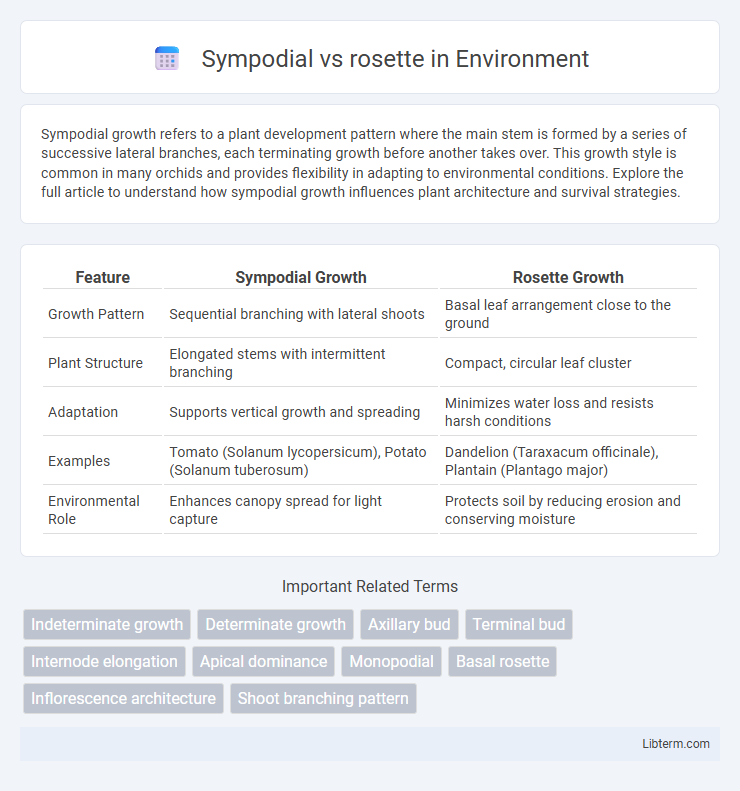Sympodial growth refers to a plant development pattern where the main stem is formed by a series of successive lateral branches, each terminating growth before another takes over. This growth style is common in many orchids and provides flexibility in adapting to environmental conditions. Explore the full article to understand how sympodial growth influences plant architecture and survival strategies.
Table of Comparison
| Feature | Sympodial Growth | Rosette Growth |
|---|---|---|
| Growth Pattern | Sequential branching with lateral shoots | Basal leaf arrangement close to the ground |
| Plant Structure | Elongated stems with intermittent branching | Compact, circular leaf cluster |
| Adaptation | Supports vertical growth and spreading | Minimizes water loss and resists harsh conditions |
| Examples | Tomato (Solanum lycopersicum), Potato (Solanum tuberosum) | Dandelion (Taraxacum officinale), Plantain (Plantago major) |
| Environmental Role | Enhances canopy spread for light capture | Protects soil by reducing erosion and conserving moisture |
Introduction to Plant Growth Patterns
Sympodial and rosette growth patterns represent distinct strategies in plant development, influencing overall morphology and adaptation. Sympodial growth involves successive lateral shoots taking over the terminal growth, often seen in orchids and tomatoes, allowing flexible and extended growth. Rosette growth forms a compact arrangement of leaves at the base, typical in plants like dandelions and cabbages, optimizing light capture and minimizing water loss.
What is Sympodial Growth?
Sympodial growth is a plant development pattern where the main stem is formed by successive lateral branches, each growing for a limited time before being replaced by another branch. This growth contrasts with monopodial growth, where a single, continuous main stem elongates indefinitely. Sympodial structures enable plants like orchids and some shrubs to expand horizontally, promoting adaptive responses to environmental conditions.
What is Rosette Growth?
Rosette growth is a plant development pattern where leaves form a compact, circular arrangement close to the soil surface, maximizing light capture and minimizing water loss. This growth strategy contrasts with sympodial growth, where the plant produces a main stem with lateral branches arising sequentially, allowing vertical expansion. Rosette structures are common in basal plants like dandelions and cabbages, optimizing energy use in harsh environments.
Key Differences Between Sympodial and Rosette
Sympodial growth features successive lateral shoots taking over the terminal growth, resulting in a branched structure, whereas rosette growth involves a circular arrangement of leaves at a single height, often close to the ground. Sympodial plants, such as certain orchids and tomatoes, display elongation with multiple stems, while rosette plants like dandelions and lettuce concentrate leaves in a dense basal cluster to conserve resources. The key difference lies in stem elongation and branching patterns for sympodial types compared to the compact, ground-hugging leaf arrangement characteristic of rosettes.
Examples of Sympodial Plants
Sympodial plants exhibit a growth pattern where the main stem is formed by successive lateral branches, such as in orchids like Cattleya and Cymbidium. Tomato plants (Solanum lycopersicum) also display sympodial growth, where each shoot terminates in a flower and a new shoot grows from a lateral bud. Ginger (Zingiber officinale) is another example, showcasing horizontal rhizome expansion characteristic of sympodial development.
Examples of Rosette Plants
Rosette plants, characterized by a circular arrangement of leaves at the base, include species like dandelions (Taraxacum officinale), succulents such as echeveria, and certain types of lettuce (Lactuca sativa). These plants typically grow close to the ground, maximizing sunlight capture and minimizing moisture loss, making them well-suited to harsh environmental conditions. Unlike sympodial growth, which involves branching and sequential differentiation, rosette plants maintain a compact form that supports efficient nutrient storage and protection from herbivory.
Functional Advantages of Sympodial Growth
Sympodial growth offers enhanced structural support by producing lateral shoots that enable the plant to better withstand environmental stresses such as wind and herbivory. This growth pattern facilitates continuous reproduction and resource allocation by allowing successive growth units to develop, increasing overall plant vigor and longevity. Unlike rosette growth, sympodial plants can expand spatially, optimizing light capture and space utilization for improved photosynthesis and competitive advantage.
Functional Advantages of Rosette Growth
Rosette growth offers significant functional advantages by allowing plants to maximize light capture close to the ground, enhancing photosynthetic efficiency in low-competition environments. This growth form also improves resistance to herbivory and environmental stress by keeping vital tissues protected near the soil surface. Furthermore, rosette plants often exhibit improved water retention and nutrient uptake due to their compact leaf arrangement, making them well-adapted to harsh climates and nutrient-poor soils.
Sympodial vs Rosette in Horticulture
In horticulture, sympodial growth involves lateral branching where the main stem is formed by successive shoots, resulting in a bushier plant structure ideal for crops like tomatoes and orchids. Rosette growth, characterized by a circular arrangement of leaves at the base with minimal stem elongation, is common in plants such as lettuce and dandelions, promoting compactness and energy conservation. Understanding the differences between sympodial and rosette growth enables precise cultivation techniques tailored to plant morphology and productivity.
Choosing the Right Growth Habit for Your Garden
Selecting the appropriate growth habit between sympodial and rosette plants depends on your garden's space and design goals. Sympodial growth, characterized by lateral branching and continued shoot development, suits gardens aiming for vertical layering and dynamic structure. Rosette growth, with its compact leaf arrangement near the ground, works well for creating dense, ground-covering beds and minimizing soil erosion.
Sympodial Infographic

 libterm.com
libterm.com